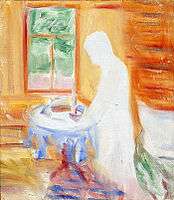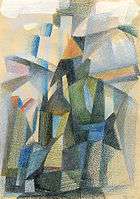Museum of Organic Culture
 | |
| Established | 2011 |
|---|---|
| Location | 140400, 10, Kazakova str., Kremlin, Kolomna, the Moscow region, Russia |
| Type | Russian avant-garde |
| Director | Tatyana Kilya |
| Website | museumart.ru |
Museum of Organic Culture (abbreviated as MOC) (Russian: Музей органической культуры) is located in Kolomna, Russia, in merchant Lvov’s estate, a monument of wooden architecture of the XIX century.[1] The museum has been organized on the initiative of Alla Povelikhina, Nina Suyetina, Vasily Rakitin and Elena Rakitina, and Irina Alikina. The museum houses a unique collection of works of Russian avant-garde of the early twentieth century.[1][2][3]
Activities
In its activities, MOC presents the story of the formation and development of the organic[4] trend in modern Russian art.[5][6]
Collection
Museum of Arts of the XX-XXI centuries
The permanent exposition of Museum of Arts of the XX-XXI centuries displays the works of Elena Guro and Mikhail Matyushin - the key personalities of Organic Culture.
In 1923-1926 Michael Matyushin headed the Department of Organic Culture in GINKhUK (the State Institute of Artistic Culture). The aim of the department was to determine, confirm or specify empirically with laboratory test results naturally observed dynamics and patterns of interaction of the principal means of plastic language – shape and colour – and later on to study the effect of sound on these means. The peculiarity of the study of color, shape and sound was that they were studied and empirically observed not in isolation, taking into account the spatial environment incorporating the objects of observation. This was achieved due to the "advanced vision" "ZOR-VED" (vision + cognition), which created the understanding of interconnections, "fusion of essences but not of semblances".
The most outstanding masters belonging to this trend were brother and sisters Boris, Maria, and Ksenia Ender.
Part of the Museum`s collection is completed with works of St Petersburg`s artist Vladimir Sterligov, who developed the theory of an additional element in art, as well as works of Tatiana Glebova, Pavel Kondratiev, Elizaveta Aleksandrova, A. Baturin and others.[2]
 Elena Guro. Portrait of Mikhail Matyushin. Late 1900s.
Elena Guro. Portrait of Mikhail Matyushin. Late 1900s. Mikhail Matyushin Son. 1910
Mikhail Matyushin Son. 1910 Mikhail Matyushin Landscape with Huts. 1904
Mikhail Matyushin Landscape with Huts. 1904 Mikhail Matyushin Elena Guro’s Portrait. Late 1900s.
Mikhail Matyushin Elena Guro’s Portrait. Late 1900s. Elena Guro A Stone in Water. 1910
Elena Guro A Stone in Water. 1910 Vladimir Sterligov Petergof. 1960
Vladimir Sterligov Petergof. 1960 Pavel Kondratiev. Multidimensionality. 1971
Pavel Kondratiev. Multidimensionality. 1971
Museum of Russian Photo Art
The permanent exhibition of the Museum of Russian Photo Art "Historical Pages" presents the following areas of photographic art: pictorialism (artistic photography), landscape pictures (location photography), ethnographic photography of the second half of the XIX century, documentalism, and studio photography.
Museum of Traditions
Museum of Traditions is still in the process of formation; its exposition includes works of archeology and crafts, as well as works of the artists who had a naive attitude to their surrounding reality: Pavel Leonov, Katya Medvedeva, Taisiya Shvetsova, Lyudmila Voronova, Lyubov’ Maykova and others.
Publications of the Museum of Arts of the XX-XXI centuries
- Mikhail Matyushin. Creative Path of the Artist. - IOC. Edited by Alla Povelikhina. Kolomna. 2011. ISBN 978-5-4253-0274-8
- Museum of Arts of the XX-XXI centuries. Catalogue of 2013. M .: Museum of Organic Culture. 2013 ISBN 978-5-4253-0749-1
- Culture and liturgical singing iconosphere in ancient Russia Vladimir Martynov. M .: 2014. Museum of Organic Culture. ISBN 978-5-4253-0667-8
- Sterligov’s Geometry of Nature. Dedicated to Vladimir Sterligov’s 110th anniversary. Catalogue of the exhibition. M .: Museum of Organic Culture, 2014. ISBN 978-5-905942-60-0
- Colour Music of Tatiana Glebova. Dedicated to the 115th anniversary of the artist. Exhibition Catalogue of 2015. MOC. ISBN 978-5-519-48596-8
- Freedom of Simple Forms. Sergei Reznikov \ Vasily Romanenko. M .: Museum of Organic Culture, 2013 ISBN 978-5-4253-0647-0
- The Organic Movement in the Art of the XX-XXI Centuries. Scope of the Earth. Exhibition Catalogue of 2012. MOC
- Back to Nature. Conversation 0/1 2012-08-30. Museum of Organic Culture. 2012
- Back to Nature. Conversation 0/2 2013-08-30/ East and West. The Great Silk Road. Museum of Organic Culture. 2013
Links
- The Museum Official Site
- (Russian) MOC Page in the "Museums of Russia"
- Official page of Museum of Organic Culture on Facebook
- National Center for Contemporary Art
- State Museum of St. Petersburg’s History
- Conversations about Organics 0/3 - 28/09/2014
Publications about the museum in the travel guides
References
- 1 2 Museum of Organic Culture has been opened in Kolomna near Moscow. Official website of the TV channel "Culture". Culture (01.09.2011).
- 1 2 Pavlikova, Alla. A new format for new art. Three concepts of Yuri Avvakumov. Architectural Herald, № 3 (108) (29 September 2008). - "... A unique collection of works of Russian avant-garde of the early twentieth century is presented. By the mid-1910s avant-garde art had identified several areas, including the "organic" one”. Accessed on: July 8, 2015. Archived from the original source on 8 July 2015.
- ↑ (Russian) Museum of Organic Culture has opened an exhibition of cultural heirs of the Russian avant-garde. TV channel "Culture", (4 September 2012)
- ↑ Lossky N. The world as an organic whole. - MOC. - 2014.
- ↑ “Great Utopia” has been performed in Moscow, but in New York it was even greater”. "Kommersant” № 79 (29.04.1993)
- ↑ Organica / Edited by Alla Povelihinoy and others. - Galerie Gmurzynska. - 1999.
- Organica. Curated by Alla V.Povelikhina.2000. Galerie Gmurzynska.
- Mikhail Matyushin. The Creative Path of the Artist. - Museum of Organic Culture. Kolomna. 2011. ISBN 978-5-4253-0274-8
- Victory over the Sun. Published in the framework of the exhibition
- "Museum of the Great Hopes". Arsenal, NCCA, the Volga-Vyatka branch. According to the publication "The Creative Path of the Artist", Museum of Organic Culture, 2011
- Efimov A.V. Colour + Form. Art of the 20-21st centuries (painting, sculpture, installation, land art, digital art). Moscow. BuksMArt, 2014-616 p. "Organics" - pages 181-197. ISBN 978-5-906190-14-7
- Mikhail Matyushin. Professor of the Academy of Arts. - M .: HT-Print 2007.
- Margareta Tilberg. Colour Universe. Mikhail Matyushin about Art and Vision. - M.: Novoye Literaturnoye Obozreniye, 2008.
- Povelikhina A.V. Velimir Khlebnikov in St. Petersburg-Petrograd: Description of the Exhibition in State Museum of the History of Leningrad. - L., 1986.
- Povelikhina Alla, Evgeny Kovtun. Russian Pictorial Sign and Avant-Garde Artists. - L .: Aurora, 1991. - 200 p. - 2000 copies - ISBN 5-7300-0274-2.
- Elena Guro – the Poet and Painter, 1877-1913: Paintings, drawings, manuscripts, books: Catalogue of the exhibition / Compilation and the introductory article of A.V. Povelikhina; State Museum of the History of St. Petersburg, Handwriting Department of Russian Literature Institute, Russian State Archive of Literature and Art. - SPb .: Mifril, 1994. - 113 p. - ISBN 5-86457-007-9.
Coordinates: 55°06′15″N 38°45′22″E / 55.1042°N 38.7561°E